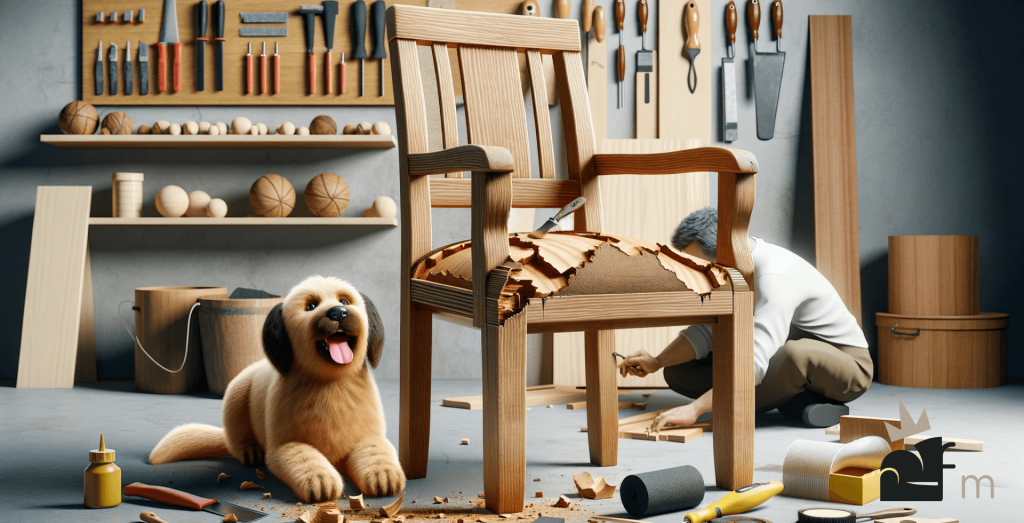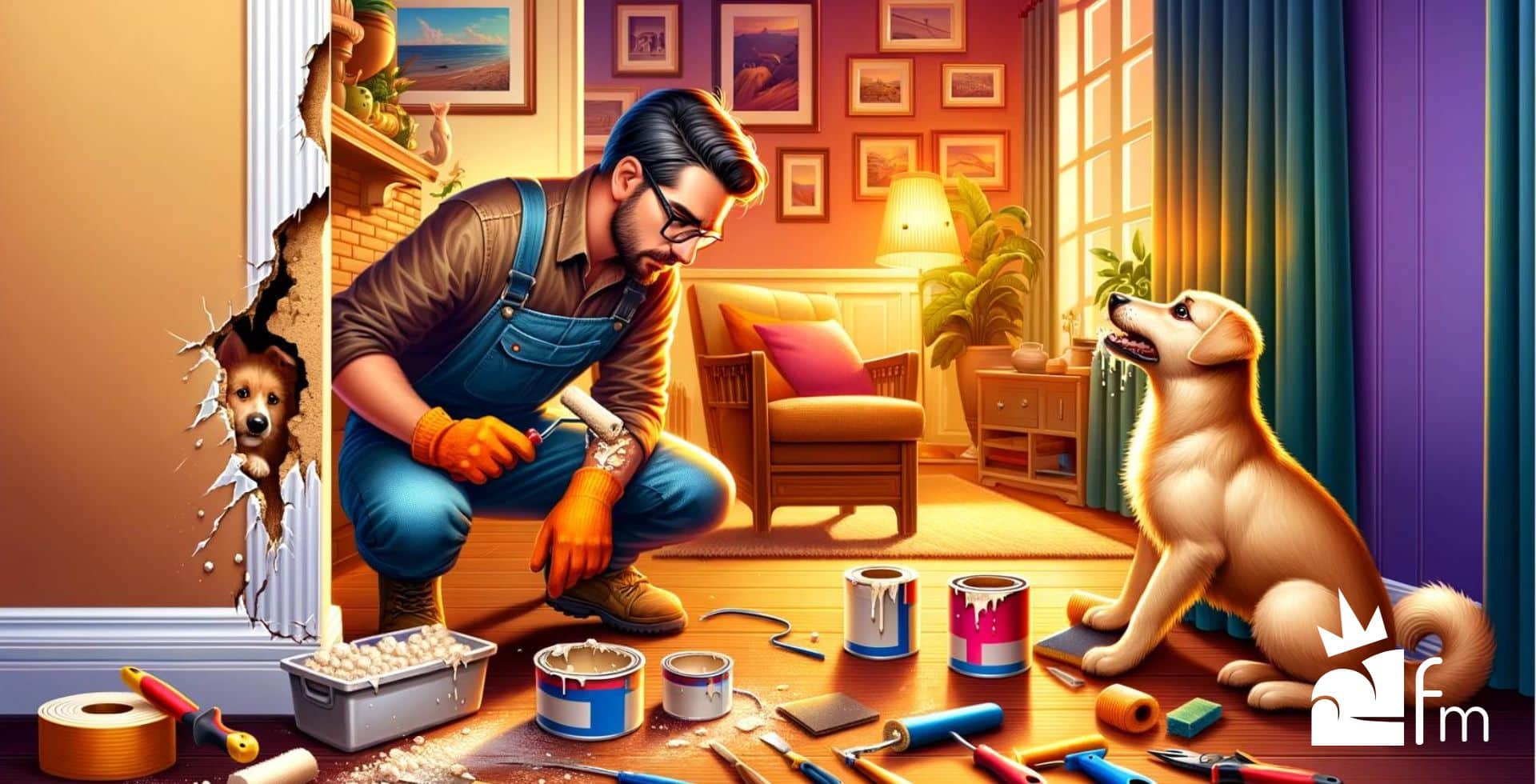Are you trying to fix your dog’s chewed areas of your wall and prevent it from happening? Then, you are at the right article.
Walls protect and improve the beauty of your house, yet your pet can sometimes ruin their graceful look. The problem is you can do nothing against your innocent, cute companion; telling them to stop is also a waste of time.
Most of the problem comes afterward, when you have to fix the wall. You may encounter situations like ruining the paint of the wall, breaking its proportion, or even tearing of wall panels.
So, is fixing dog-chewed corners of your wall hard to fix? Do they require an expert’s help? Well, not necessarily. With a bit of wall-mending knowledge and simple tips, you can fix your dog’s chewed area in no time. Also, why pay for a job that you can easily handle on your own.
Below, we will discover some of efficient tips and tricks on how to fix the corner of the wall that the dog chewed.
Let us begin,
Why Do Dogs Chew Wall Corners?
It’s not like your dog just wanted to chew a piece of wall and did; there are some scientific reasons behind this type of behavior.
i. Boredom
When you’re not at home or when you’re too busy to engage with your dog, they may find themselves feeling bored. Boredom can quickly lead to destructive behaviors such as chewing wall corners. For instance, you might notice the damage occurs most often when you’ve been gone for an extended period, leaving your dog without activities or stimulation.
ii. Anxiety or stress
Chewing can also be a coping mechanism for dogs experiencing anxiety or stress. Events such as thunderstorms, fireworks, or unfamiliar faces in the house can be stressful for a dog, leading them to chew on wall corners or other objects to relieve tension.
iii. Teething
Young dogs and puppies often experience discomfort due to teething. This discomfort can be alleviated to some extent by chewing, making wall corners a convenient target for their sore gums. If you have a puppy that’s only a few months old, teething could likely be the reason for the chewing.
iv. Lack of exercise
Inadequate physical exercise can result in a buildup of energy in dogs. When dogs don’t get a sufficient outlet for this energy, they may resort to activities like chewing to burn it off. A dog that hasn’t been walked or played with for a considerable amount of time might start targeting wall corners.
v. Seeking attention
Some dogs chew as a way to seek attention. The act is often purposeful; they chew because they know it will prompt a response from you. This is especially common when the dog feels that it is not receiving adequate attention or engagement, for example, when you’re busy on a phone call.
vi. Nutritional Deficiency
Lacking certain nutrients in their diet can also lead dogs to chew on walls or other inedible objects. If your dog is on a restricted or poor-quality diet, they may try to supplement it by consuming substances found in wall corners, even though this is not a healthy or effective solution.
vii. Behavioral Issues
Lastly, some dogs chew on wall corners due to deeper, ingrained behavioral issues. In these cases, the action is a symptom of a more complex issue that may require professional behavioral training to correct. It can happen regardless of environment, level of engagement, or attention from the owner.
What are Some Prevention Measures?

Understanding that your dog’s chewing behavior can be a source of stress, it’s important to note that there are several proactive measures to prevent this from happening. First and foremost, make sure to give your dog ample exercise; a well-exercised dog is less likely to display destructive behavior.
Additionally, a variety of chew toys should be supplied to offer a more suitable alternative for their chewing needs. Consider applying a pet-friendly chew deterrent spray on the wall corners that are most commonly targeted. This can make the area less appealing to your furry friend.
If stress or anxiety is the underlying issue, consult a veterinarian or animal behaviorist for specific recommendations. To physically keep your dog away from the walls, think about using baby gates or other barriers to limit access to these areas.
Finally, employ training and positive reinforcement methods to guide your pet toward better habits. Addressing the issue from multiple angles will not only provide immediate relief but also foster a more harmonious living environment in the long run.
7 Methods to Fix Dog Chewed Corners of Your Walls
There can be plenty of reasons for your dog to chew your wall corner, but there is only one reason for you to fix your walls, and that is beauty. If you make one mistake in the process, your precious wall will be gone for good.
1. Sand down damage
Initiate the repair process by sanding down the damaged area using medium-grit sandpaper. This step removes jagged edges and splinters, providing a smooth surface for other repair materials to adhere to. You might find that going over the damaged area multiple times with sandpaper of increasing grit will yield the best results.
2. Apply wood filler
Following the sanding, it’s time to apply a quality wood filler to the damaged corner. This step is essential for reconstructing the chewed area and bringing it back to its original form. A putty knife can be an invaluable tool for this step, allowing you to shape the wood filler precisely so it matches the surrounding area.
3. Prime the area
After the wood filler has dried adequately, apply a coat of primer to the affected area. This is crucial for sealing the wood filler and preparing the surface for painting. Priming ensures that the subsequent paint layer will adhere correctly and produce an even color. A good quality primer can make a world of difference in achieving a professional finish.
4. Paint matching
Now that your wall is primed, the next step is to paint the repaired area. Accurate color matching is imperative here to make the corner blend seamlessly with the rest of the wall. You could take a small sample or chip off the existing wall paint to your local paint store to ensure you get the closest possible match.
5. Chew deterrent spray
Once the paint has dried, applying a chew deterrent spray can be very effective in preventing future incidents. These sprays have a taste and odor that are unpleasant for dogs but are usually completely pet-safe. It’s a good idea to apply the spray periodically, especially in the initial weeks after repair, to reinforce the no-chewing message to your dog.
6. Install corner guards
Installing corner guards adds an extra layer of protection to your freshly repaired wall. Made from materials like plastic or metal, these guards act as a physical barrier against your pet’s chewing tendencies. When installing, make sure the guards are securely attached and that they match the color and style of your room to maintain aesthetic integrity.
7. Add protective wall covering
For maximum protection, consider adding a protective wall covering over the repaired area. Whether it’s heavy-duty wallpaper, acrylic panels, or another form of wallboard, a durable wall covering can act as a final defense against your dog’s chewing habits. Make sure to choose a material that is both robust and easy to clean, and that fits well with your interior design theme.
FAQ on How to Fix Corner of Wall that Dog Chewed
How to seal wall corners?
Sealing wall corners is an indispensable step for any home or renovation project. It serves as a moisture barrier, aids in temperature control, and offers an added layer of protection against insects or other small intruders.
The key is to select a high-quality silicone or acrylic caulk. Using a caulk gun, apply the sealant along the interior and exterior corners, smoothing it out with a caulk smoother or your finger. Let it dry according to the manufacturer’s recommendations to ensure it sets properly. A well-sealed corner isn’t just functional; it also provides a polished, finished look to your walls.
How to fix a dog-chewed wood corner of a table?
If your dog has decided that the corner of your wooden table makes an excellent chew toy, don’t despair. Start by sanding down the damaged area to remove splinters and create a smooth surface.
Next, use a wood filler or epoxy to rebuild the damaged corner. This might take several layers, depending on the extent of the damage. After the filler dries, sand it smooth and prepare it for painting or staining. Select a paint or stain that closely matches the rest of the table. Finally, consider adding a pet-safe deterrent spray to dissuade future chewing.
Should you fix a wall while painting it?
When undertaking a painting project, skipping straight to the transformational act of adding color is tempting. However, painting should be viewed as the final step in a longer process. Taking the time to repair holes, dents, or other damages is essential for achieving a professional, polished finish.
After your repairs are complete, apply a high-quality primer to your wall. This will help to hide repairs and make your paint job last longer. The extra effort up front will yield a vastly superior result.
How to fix wood dents?
Dents in wooden furniture or flooring are common but fixable issues. One surprisingly effective method involves using water and a hot iron. Dampen a cloth and place it over the dented area.
Apply a hot iron on the cloth, which will make the water steam and cause the compressed wood fibers to expand back to their original form. After this, you may need to do some light sanding to make the surface perfectly smooth. Then, apply a matching stain or paint to blend the repaired area with the surrounding wood.
How to smooth a wall without plastering?
Sometimes, plastering isn’t an option, whether due to time constraints or material concerns. In such cases, a joint compound or a skim coat can be a lifesaver. These substances can be applied directly onto the wall surface using a trowel or putty knife.
You’ll typically need to apply multiple thin layers, sanding between each one to ensure a smooth finish. Once the final layer has dried, you’re ready to paint or wallpaper over it.
Our Verdict
And that’s everything you need to know about fixing the chewed corners of your wall. However, considering this situation as an issue might only be overexaggerated.
Well, this problem doesn’t just challenge the integrity of your home; it also provides an opportunity for you to showcase your skill and creativity in home improvement. With the right approach, you transform a cosmetic nuisance into an achievement you can take pride in.
As you venture into these repairs, remember the real value isn’t just in the physical transformation of the space but also in the skills and knowledge you gain. These techniques don’t merely serve to fix a single corner; they arm you with the expertise to handle future incidents proactively.
In essence, each repair situation is a learning experience, making you better prepared for any home challenges that lie ahead.
Best regards!

